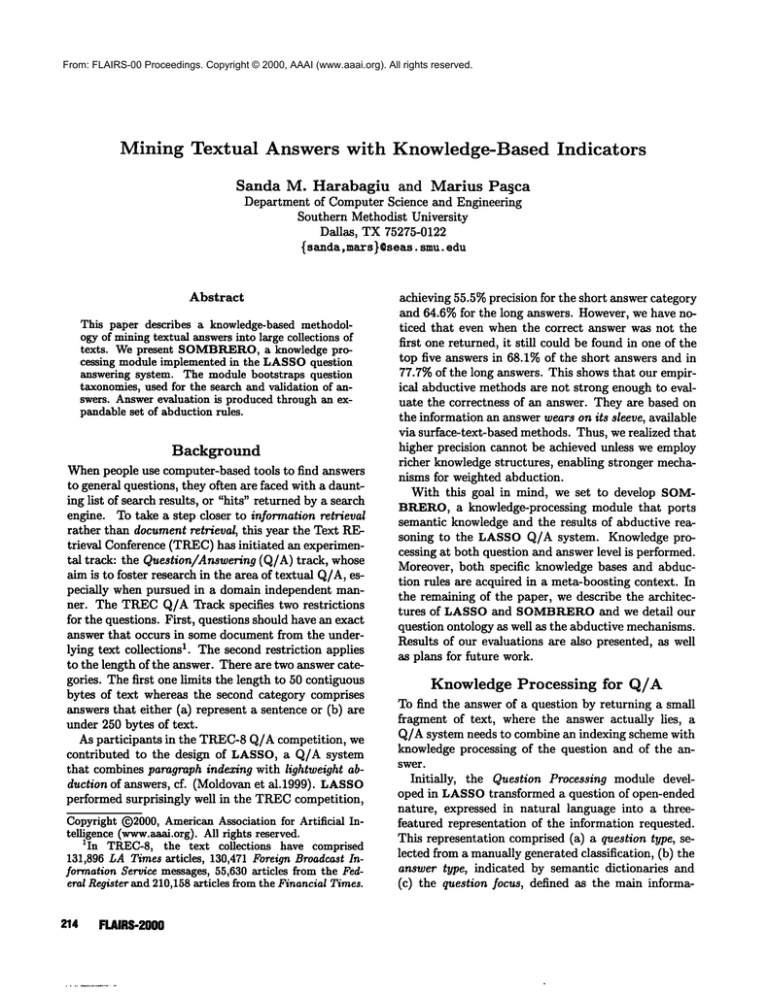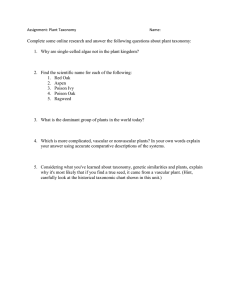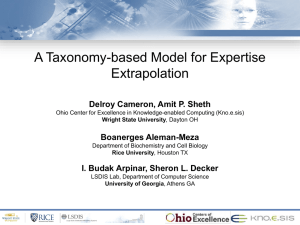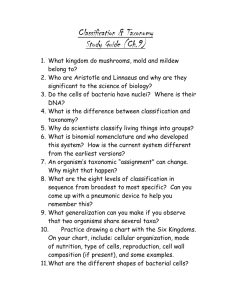
From: FLAIRS-00 Proceedings. Copyright © 2000, AAAI (www.aaai.org). All rights reserved.
Mining Textual
Answers with Knowledge-Based
Indicators
Sanda
M. Harabagiu
and Marius
Pa~ca
Department of Computer Science and Engineering
Southern Methodist University
Dallas, TX 75275-0122
{sanda,mars}@seas.
smu.edu
Abstract
This paper describes a knowledge-based methodologyof miningtextual answersinto large collections of
texts. We present SOMBRERO,
a knowledge processing module implemented in the LASSOquestion
answering system. The module bootstraps question
taxonomies, used for the search and validation of answers. Answerevaluation is produced through an expandable set of abduction rules.
Background
Whenpeople use computer-based tools to find answers
to general questions, they often are faced with a daunting list of search results, or "hits" returned by a search
engine. To take a step closer to information retrieval
rather than documentretrieval, this year the Text REtrieval Conference (TREC)has initiated an experimental track: the Question/Answering (Q/A) track, whose
aim is to foster research in the area of textual Q/A,especially when pursued in a domain independent manner. The TRECQ/A Track specifies two restrictions
for the questions. First, questions should have an exact
answer that occurs in some document from the underlying text collections 1. The second restriction applies
to the length of the answer. There are two answer categories. The first one limits the length to 50 contiguous
bytes of text whereas the second category comprises
answers that either (a) represent a sentence or (b)
under 250 bytes of text.
As participants in the TREC-8Q/A competition, we
contributed to the design of LASSO,a Q/A system
that combines paragraph indexing with lightweight abduction of answers, cf. (Moldovan et al.1999). LASSO
performed surprisingly well in the TRECcompetition,
Copyright (~2000, AmericanAssociation for Artificial Intelligence (www.aaai.org).All rights reserved.
1In TREC-8, the text collections have comprised
131,896 LA Times articles, 130,471 Foreign Broadcast Information Service messages, 55,630 articles from the Federal Register and 210,158articles fromthe FinancialTimes.
214
FLAIRS-2000
achieving 55.5%precision for the short answer category
and 64.6% for the long answers. However, we have noticed that even when the correct answer was not the
first one returned, it still could be found in one of the
top five answers in 68.1% of the short answers and in
77.7% of the long answers. This shows that our empirical abductive methods are not strong enough to evaluate the correctness of an answer. They are based on
the information an answer wears on its sleeve, available
via surface-text-based methods. Thus, we realized that
higher precision cannot be achieved unless we employ
richer knowledgestructures, enabling stronger mechanisms for weighted abduction.
With this goal in mind, we set to develop SOMBRERO,a knowledge-processing
module that ports
semantic knowledge and the results of abductive reasoning to the LASSOQ/A system. Knowledge processing at both question and answer level is performed.
Moreover, both specific knowledge bases and abduction rules are acquired in a meta-boosting context. In
the remaining of the paper, we describe the architectures of LASSO and SOMBRERO
and we detail our
question ontology as well as the abductive mechanisms.
Results of our evaluations are also presented, as well
as plans for future work.
Knowledge Processing for Q/A
To findtheanswerof a question
by returning
a small
fragment
of text,wherethe answeractually
lies,a
Q/A systemneedsto combine
an indexing
schemewith
knowledge
processing
of thequestion
andof the answer.
Initially,
the Question Processing module developed in LASSOtransformed a question of open-ended
nature, expressed in natural language into a threefeatured representation of the information requested.
This representation comprised (a) question ty pe, selected from a manually generated classification, (b) the
answer type, indicated by semantic dictionaries and
(c) the question focus, defined as the main informa-
F-’~’~on Taomnomy
SOMBRERO
SemandcRegesentation of
Answer
AnswerCorrectness
Semantic
Representationof
Question
DocumenU
Question
Amwer(s)
LASSO
Answer
Identiflcaficm
~estioa Focus
QuestionKe~m,ords
No
~uestion Processing
Yes
ParagraphIndexing
Figure 1: SOMBRERO:
A knowledge processing
Allswe,
F
Extraction
AnswerProcessing
module for the LASSOQ/A System
engine,
producing
an Information
Retrieval
(IR)loop
tionrequired
by theinterrogation.
Furthermore,
the
QuestionProcessing
modulefromLASSOidentifies
thatincreases
theoverall
quality
oftheretrieval.
Howthe question
keywords
thatservein theretrieval
of
ever,fromour experiments,
we havedetermined
that
the answers.All the QuestionProcessing
performed
theIR precision
and theoverallperformance
of the
in LASSOis of empirical
nature.
Q/Asystemis influenced
in largemeasure
by thequality of the keywords.To addressthis issue,SOMTo be ableto addressa largervariety
of question
BREROhas generates
keywordsby usingthe semantic
classesandespecially
to providea richersemantic
representation
of
the
question,
thusimproving
thepreknowledgerepresentation,
we have developedSOMcision
of
LASSO.
BRERO,a knowledgeprocessing
modulethatgeneratesthequestion
type,theanswertype,thequestion
The Answer Processing module parses the parafocusand the question
keywords
basedon a semantic
graphs that contain the question keywords, and idenrepresentation
of thequestion.
As illustrated
in Figtifies answer candidates, based on the answer type.
ure1, firstthequestion
is parsed
andlexico-semantic Answers are then extracted, by using shallow abducpatterns
areapplied
to detectsemantic
regularities. tire mechanisms, working on bag-of-words approaches.
Then,thequestion
is classified
against
a taxonomy
of
The results of LASSOin the TREC-8 Q/A competiquestions,
generating
thesemantic
representation
of
tion and some of our experiments have indicated that
thequestion.
Thisrepresentation
willalsobe usedin
greater precision can be achieved if answer correctness
theevaluation
of thecorrectness
of theanswer.
could be evaluated.
Basedon the question
keywords,
the Paragraph
InIn SOMBRERO,
we translate
the candidate answer
into the same semantic representation as the question.
dexin9modulefromLASSOproducesa set of ordered
paragraphs,
in whichall the keywords
werefoundby
A set of abductive rules controls the unification of the
booleanmatching.
Paragraph
indexing
is one of the
two representations.
Weimplement a weighted abmajorinnovations
of LASSO,sinceit returnsparaduction, that generates scores of answer correctness.
graphsof interest
insteadof documents
of interest.
Whenthe abduction is successful, the answer is proMoreover,
whenthe paragraph
qualityis notacceptduced. Otherwise, keyword expansion of unmatched
able,another
setofkeywords
issubmitted
to thesearch
terms takes place, and the retrieval resumes. If this
NATURAL
LANGUAGE
PROCESSING 215
second retrieval loop does not improve the correctness
scores, the search for an answer is abandoned.
A Question
FLAIRS-2000
1
Focus
Question Stem Who]
Taxonomy
Our question taxonomy is based on two principles.
First, we used a top-level categorization and a set of
constraints that define a seed hierarchy of questions.
On top of this, we define a new representation of each
question, defined by a pair of a (a) generally ambiguous question stems (e.g. what, where) (b) a semantic
representation. Second, based on this representation,
we learn classification rules, as well as new classes of
questions.
The top-level categorization is provided by the taxonomyintroduced in (Graesser et al.1992). This classification has the advantage that it has been empirically evaluated for completeness. The seed taxonomy
was further refined by constrains defined in qUALM,
the computational theory of Q/A reported in (Lehnert 1978). The major question classes are: (1) Verification (e.g. Is a fact true? Did an event occur?);
(2) Comparison (e.g. Howsimilar/different
is X from
Y?); (3) Disjunctive (e.g. Is X or Y true?); (4) Concept completion (e.g. Who...? What...? When...?
Where...? Which...?); (5) Definition/Example (e.g.
What are the properties of X?); (6)Quantification (e.g.
Howmuch...? Howmany...?); (7) Feature specification
(e.g. What is the attribute of X?); (8) Causal antecedent/consequent (e.g. What caused some event?);
(9) Procedural (e.g. What instrument enables an act?)
(10) Expectational/Analogical
(e.g. Why did some
event not occur?) and (11) Judgemental (e.g. Request
for a judgemental/advise/interpretation).
Our contribution to the taxonomy is determined by
(a) a new representation of questions and (b) a metabootstrapping mechanism that allows to learn both
new question classes and new classification
rules at
the same time. Our representation
combines lexical
elements with a semantic structure that relates the
answer type imposed by the meaning of the question
with the question focus and the other concepts of the
question. Figure 2 illustrates some of the representation used in the Concept completion class of questions,
which represents the most numerous sub-hierarchy.
In Figure 2, we illustrate
three subclasses, the
NAMEquestions, that look for an answer represented
as a named entity, the PRODUCT
class, associated
with answers that represent artifacts or other creations
and the MONEYclass,returninganswersthata numericvaluesof different
kindsof currencies.
Fora
questiontype,we may havemultipleanswertypes.
For example,whenaskingabouta namedentity,we
mayask abouta person,a product,
an organization,
216
SemanticStructure
B -Verb
I
Question Type /LO Product [
1 :u~AMoEns-- ~0 Organization
~0
SemanticStructure
[ PRODUCTION-Verb
Focus
¯/
uesti°n
stem."
what
I[Q
Disease
]
Question Type [I Exampl~
_
~
f
~
i
~ lI What
is~ord
exporting?
[Concept completion~ PRODUCT l [’
1
1
Question Type Answer Type
\Answer Type
QMOestiNEonY
] ~),Currency
[l~[O Artifact
’---’’ ~.
’/,
\
Semantic Structure /
~ Semantic Structure
V~ALUE-Category
I C..OST-Verb
QuestionStem: What
Example:
What
is the worth of
an Oscar award?
Question Stem: Howmuch
Example:
Howmuchdid Marlboro
spend
onlegal fees?
Figure 2: A snapshot from the Question Taxonomy
a disease
or a location.
In turn,to eachanswertype,
we associate
multiple
semantic
representations
of questions.A semanticrepresentation
in SOMBREROis
a caseframewithanonymous
relations,
thatwouldallowtheunification
of theanswerandof thequestion
regardless
of thecaserelation.
Two caseslotshave
special
meaning
in thisrepresentation:
(1)theanswer
type,represented
witha question
markin thequestion
frame,andunifiable
withtheanswertyperecognized
in a text,and(2)thefocus,
whoseposition
is defined
as an adjunct
or parallel
of theanswer
typein thesyntacticparse.Thekeywords
areallsyntactic
adjuncts
of the question focus.
A set of classification rules is associated with this
taxonomy.Initially, all rules are based on the recognition of the question stem and of the answer type, obtained with class information from WordNet. However
we could learn new rules when we allowed for morphological and semantic extensions of the terms from
the semantic representations of the initial taxonomy.
Along with the new rules, we enriched the taxonomy,
as a result of new questions being unified only partially
with the current taxonomy. Moreover, the training
data is easily accessible, since there are a large number
of FAQ(frequently asked questions) available on the
Internet.
The bootstrapping
algorithm
thatallowsto learn
new classification
rulesand new classesof questionsis basedon an information
extraction
measure:
score(rulei)=Ai * log2(N~), where Ai stands for the
numberof different lexicon entries for the answer type
of the question, whereas Ni = Ai/Fi, where Fi is the
number of different focus categories classified. The
steps of the boostrapping algorithm are:
1. Retrieve concepts morphologically/semanticallyrelated
tothe semantic representations
~. Applythe classification rules to all questionsthat
contain any newly retrieved concepts.
3. New_Classificatiton_Rules={}
MUTUAL BOOTSTRAPPING LOOP
4. Scoreall newclassification rules
5. best_CR=thehighest scoring classification rule
6. Addbest_CRto the classification rules
7. Add the questions classified by best_CRto the taxonomy
8. Gotostep 4 three times.
9. Discardall newrules but the best scoring three.
I0. Goto 4. until the Q/A performanceimproves.
Answer Processing
In (Hobbs et al.1993) a method of abductive interpretation of texts was introduced, describing its operation in the TACITUS
system. This method imposes two
challenging conditions: (a) exhaustive world knowledge representation and (b) the capability of limited,
efficient backward chaining. For a Q/A system, these
requirements are impractical. However, the need for
answer abduction is determined by the limited performance of bag-of-words approaches to answer extraction.
In SOMBRERO
we provide with several abductive
rules that mine successfully the correctness of answers
from the knowledge available at hand. Two factors
have impacted the precision enhancement of LASSO.
First, the question taxonomy provides with correct
recognition of the question focus. In SOMBRERO
we
discard all candidate answers that do not contain the
question focus. Only this requirement has impacted on
the precision of LASSOin two major ways: (a) correct answers that were not top-ranked in LASSOnow
become the first answer returned in 18 of the cases;
(b) 7 questions that did not have correct answers were
solved successfully. Table 1 illustrates
two such examples of TREC-8question whose answer is improved
SOMBRERO.
The answer of question 26 was initially
placed on the second position (out of five), being incorrectly preceded by an answer that did not contain the
focus. In the case of TRECquestion 198, no correct
answer was initially
found. With the means of focus
detection, the correct answer is retrieved. In both examples, the question focus is underlined.
Question-26Whatis thenameof the"female"
counterpartofElNino,
which
results
incooling
temperatures
andverydryweather?
Answer
Score: 416.00 The Timesbelieves that the
greenhouseeffect and El Nino- as well as
(short)
its "female" counterpart, La Nina - have
had a profound effect on weather
Question-198
Howdid Socrates .die?
Answer
Score: 144.00 refute the principle of
(long)
retaliation that Socrates , whowas
sentenced to death for impiety and the
corruptionof the city ’ s youth , choseto
drink the poisonous hemlock, the
state ’ s methodof inflicting death
Table 1: Examples of improved answer correctness.
The second impact of the question taxonomy on the
evaluation of answer correctness comes from the unification of the semantic representations of the question
and the answer. Our abduction rules enable this unification, by providing approximations of the semantic
information. In fact, we perform a weighted abduction, that takes into account semantic distance between
question and answer concepts. Someof the abductive
rules are:
¯ Abduction Rule 1. If the unification of the question
and answer representations comprises the focus, if one
of the concepts in the answer disambignates the corresponding question concept, assign a score equal to #
identical concepts/# unifiable concepts. An example
is:
TRECQuestion57: Whendid Nixondie?
/ DEATH-verb
~.~
Nixon
President
Richard
Nixon
DEATH-verb
DATE:April221994
/
Answer:PresidentRichardNixondied on April 22, 1994.
¯ Abduction Rule ~. If the unification of the question
and answer representations involves temporal inclusion
or overlap of the verb controlling the focus, assign a
score equal to # identical concepts + # concepts controlled by the temporal event/ # unifiable concepts.
An example is:
TRECQuestion 54: Whendid Spain and Korea start ambassadorial relations?
/
START-verb
lmb~sadorial
ambassadorial
relations
relatiom ]
~ ~
DATE: 1950
ENT~-v~b"I ~
"~’~S~’n and K°rea
the twocountries
/
Answer:Gonzalesis the first Spanishofficial to visit Seoul
since the two countries entered ambassadorialrelations in 1950.
NATURAL
LANGUAGE
PROCESSING
217
¯ Abduction Rule 3. If the unification of the question
and answer representations involves an asymmetrical
relation assign a score equal to # identical concepts
+ # concepts controlled by the relation/# unifiable
concepts. An example is:
of questions and a set of 25 abduction rules. Figure 3
illustrates
the impact on the precision of LASSOin
each experiment. It is noticeable that the effect of finer
question taxonomies has greater impact than larger
number of abduction rules.
Short answers Long answers Contribution
on LASSO of SOMBRERO
I°nLASSO
I
~
TREC
question87: WhofollowedWill)’ Brondtas chancellorof the
FederalRepublic of Germany?
_....___.....~...~ SUb..~C~D-verb
chancellor
?PERSON.)"
~ W~lly Brandt
Willy Brandt
PERSON:
Helmut Schmidt chav.cellor
~
/
PRECEDE-verb
i
Answer:
FormerChancellorHelmutSchmidtsurvivedwith a l O-seatmajori
O,
majorityfrom1976-1980,andhis predecessor,Mr.Willy Brand#hada
12-seat marginfrom 1969-1972.
¯ Abduction Rule 4. If the unification of the question and answer representations involves several relations and concepts in the answer that account for the
ellipsis phenomenonin the question (i.e. they are not
mentioned, but implied) then assign a score equal to
identical concepts / # unifiable concepts + # relations
controlled by ellipsis. An exampleis:
TREC
question25: Whowasthe lendingactress in the movie
"Sleeplessin Seattle"?
Sleeplessin Seattle
Sleeplessin Seattle
PERSON:Meg
Ryan
FEATURE-verb
/
Answer:Sleepless in Seattle, a romanticcomedyfeaturing TomHanksand
Meg Rya~
The bootstrapping of abduction rules uses a similar
algorithm as the one presented for the question taxonomy. It is characterized by combinations of the seed
abduction rules. Currently we use a set of 18 seed
rules.
Evaluation
We have evaluated the contribution
of SOMBRERO
on the performance
of the LASSO Q/A system
through five experiments. In the first two experiments
we have used only the question taxonomy, without the
support of the abduction rules. The other three experiments have used the abductive component. In the
first experiment, we have employedonly the seed question taxonomy, whereas in the second experiment we
made use of the taxonomygenerated by the bootstrapping process. In the third experiment, we have used no
question
taxonomy,
buthaveemployed
theseedabductionrules,whereas
in thefourthexperiment
we have
employed
thefullsetof abduction
rules.In thefinal
experiment,
we haveusedboththebootstrapped
taxonomyand the bootstrapped
set of abduction
rules.
In theseexperiments,
we hada taxonomy
of 48 classes
21e FLAIII$-2000
Exp.l Exp.2 Exp.3
Exp.4 Exp.5
Figure 3: Experimental results
on LASSO
Conclusions
We believethatthe performance
of a Q/A systemdependson the knowledge
sourcesit employs.
In this
paperwe havepresented
theeffectof knowledge
derivedfromquestion
taxonomies
andabductive
reasoningon Q/Aprecision.
In thefuture,
we planto study
theinfluence
of additional
knowledge
on Q/Asystems.
Ourstudywillevaluate
theeffect
of knowledge
derived
from reference resolution and discourse coherence on
Q/A precision.
References
Arthur
Graesser,
Natalie
Person
andJohnHuberMechanismsthatgenerate
questions.
In Lawrence
Erlbaum
Associates,
Questions and Information Systems, pages 167187., editors Lauer, T.W., Peacock,E.and Graesser, A.C.,
Hillsdale, N.J., 1992.
Sanda Harabagiu and Steven Malorano. Finding answers
in large collections of texts: paragraphindexing + abductive inference. Working Notes of the Fall AAAI Symposium on Question Answering, November1999.
Jerry Hobbs, Mark Stickel, Dons Appelt, and Paul Martin. Interpretation as abduction. Artificial Intelligence,
63, pages 69-142, 1993.
WendyLehnert. The processing of question answering.
LawrenceErlbaumPublishers, 1978.
Dan Moldovan, Sanda Harabagiu, Marius Pa~ca, Rada
Mihalcea,
RichardGoodrum,
RoxanaGirjuand Vasile
Rus.Lasso:
a toolforsurfing
theanswer
net.In Proceedings of TREC-8,1999.







